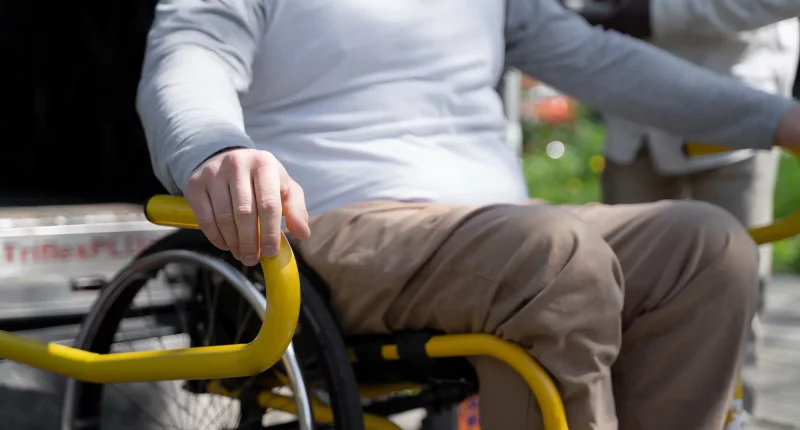Becker muscular dystrophy (BMD) is a condition that runs in families and makes muscles weaker over time. This weakness gets worse as a person grows up. It can make it hard for someone to move around, like walking. Doing normal things like getting dressed or picking up things might become tricky because of BMD.
BMD is one kind of muscular dystrophy, which is a bunch of conditions making muscles weaker and weaker as time passes.
Symptoms
BMD typically starts showing signs of muscle loss in areas like the shoulders, pelvis, hips, and thighs. Common signs of BMD encompass difficulties in walking, jumping, or running, along with frequent falls and stumbling. Climbing stairs and standing up from a lying or sitting position may become challenging, and endurance may decrease. Additionally, calf muscles may appear larger than usual. The progression of BMD symptoms tends to be gradual, stretching over several decades. By the age of 30 or later, some men with BMD may need a wheelchair, while others may rely on minor walking aids like a cane.
As BMD advances, it can lead to various complications, including cardiomyopathy, impaired liver and lung function, loss of mobility, scoliosis, cognitive decline, and an increased risk of bone fractures.
Causes
BMD happens because of genes. Genes are like instructions in our bodies. When something goes wrong with these instructions, it can cause problems. BMD comes from a change in a gene called dystrophin. This gene lives on a special part of our chromosomes, called Xp21.2.
Usually, if someone has BMD, they get it from their parents. It’s what’s called an X-linked recessive disorder. But sometimes, a person can get BMD even if their parents don’t have it. This happens because of a sudden change in the gene, not because it was passed down from the family. Doctors call this a spontaneous mutation.
Diagnose
Doctors diagnose Becker muscular dystrophy (BMD) by looking at a child’s medical history, and their family’s medical history, and doing a thorough check-up. BMD is one of the two common types of muscle problems that doctors find in kids. The other one is called Duchenne muscular dystrophy (DMD).
During the check-up, the doctor watches how the child stands up from sitting on the floor. Children with BMD might stand up in a special way because their leg muscles are weak. Doctors call this a special way of standing the Gower’s maneuver. The child starts on their hands and feet, then they push their bottoms up using their hands until they stand up straight. Doctors also watch how the child walks and check their muscles and nervous system.
To confirm if it’s BMD, doctors might do some tests:
- Blood tests: These tests can show if there are high levels of a substance called creatine kinase in the blood. High levels of this substance might mean there’s muscle damage.
- Electromyography: This test checks the electrical activity in the muscles using small electrodes on the skin. Changes in the pattern of this activity might mean the child has muscular dystrophy.
- Muscle biopsy: In this test, doctors take a small piece of muscle for testing in a lab. This helps rule out other muscle problems.
- Genetic testing: Doctors send a blood sample to a laboratory to check for certain genetic changes. Finding these changes can help determine BMD.
Treatment
Treatment options for Becker muscular dystrophy (BMD) aim to manage symptoms, slow down the development of the condition, and enhance the person’s quality of life. While there is no cure for BMD, various treatments and supportive therapies can be beneficial.
Physical therapy is a crucial aspect of BMD treatment. It typically involves exercises like stretching to enhance walking ability and maintain flexibility in stiff joints. A physical therapist might also recommend using walking braces to provide support to weakened muscles and promote flexibility.
Medication, such as corticosteroids, may be prescribed by doctors to manage BMD symptoms. Corticosteroids can help enhance lung function, delay the development of scoliosis (curvature of the spine), postpone the onset of cardiomyopathy (heart muscle disease), and prolong survival.
Assistive devices play a significant role in helping individuals with BMD maintain independence and mobility. These devices may include walkers, canes, power wheelchairs, and wheelchairs, depending on the individual’s needs and mobility level.
In some cases, surgery may be recommended to address specific issues associated with BMD, such as maintaining functional skills and treating scoliosis. The decision to undergo surgery and the specific procedures involved are typically discussed and determined by a doctor based on the individual’s condition and needs.
Prevention
Preventing Becker muscular dystrophy (BMD) involves genetic counseling and early detection methods:
Genetic Counseling
Families with a history of BMD or linked genetic conditions can benefit from genetic counseling. Genetic counselors can assess the chance of passing on the condition to future children and provide guidance on family planning options, such as prenatal testing or in vitro fertilization with genetic screening.
Prenatal Testing
For families with a known risk of BMD, prenatal testing can be offered to determine if the fetus carries the genetic mutation associated with the condition. This allows parents to make informed decisions about the pregnancy and plan for appropriate medical care if the child is diagnosed with BMD.
Newborn Screening
Some countries offer newborn screening programs to find genetic disorders like Duchenne muscular dystrophy (DMD), which is closely related to BMD. Early detection through newborn screening allows for prompt medical intervention and support, which can improve outcomes and quality of life for affected individuals.
Healthy Lifestyle
While lifestyle changes cannot prevent BMD, maintaining a healthy lifestyle can support overall well-being and potentially mitigate the progression of symptoms. This includes regular exercise, a balanced diet, and avoiding activities that may exacerbate muscle weakness or strain.
Early Intervention and Management
Timely diagnosis and early intervention with treatments such as physical therapy and medications can help manage symptoms and delay disease progression in individuals with BMD. Close monitoring by healthcare professionals can ensure that appropriate interventions are implemented as needed to optimize the individual’s health and function.
Outlook
Becker muscular dystrophy (BMD) is a genetic condition that causes progressive muscle weakness and degeneration. It primarily affects males and is caused by mutations in the dystrophin gene. While there is currently no cure for BMD, treatments such as physical therapy, medications, assistive devices, and surgery can help manage symptoms and improve quality of life.
Preventing BMD involves genetic counseling for families with a history of the condition, as well as prenatal testing and newborn screening programs. Early detection and intervention can help individuals with BMD receive appropriate medical care and support.
Maintaining a healthy lifestyle, including regular exercise and a balanced diet, can also support overall well-being for individuals with BMD. With early intervention and management, individuals with BMD can lead fulfilling lives and manage the progression of the condition effectively.
Summary
Becker muscular dystrophy (BMD) makes muscles weaker in certain parts of the body like hips, thighs, and shoulders. This can lead to problems like difficulty walking, falling often, trouble standing up, feeling tired quickly, and having weak muscles.
Sometimes, BMD can cause other health issues like heart problems, trouble breathing, liver problems, a curved spine, trouble moving around, problems thinking, and broken bones.
Unfortunately, there’s no healing for BMD. But doctors can suggest ways to help manage it. They might recommend exercises called physical therapy to make it easier to move and feel better. They can also give medicines like corticosteroids to slow down how fast BMD gets worse and delay spine problems.








